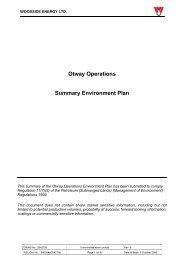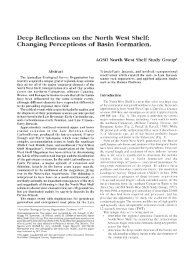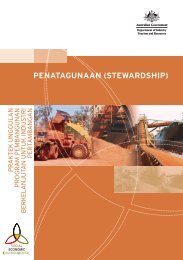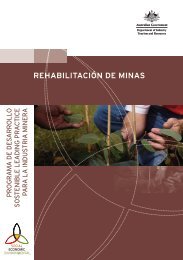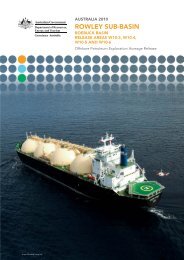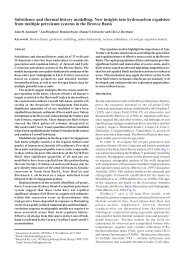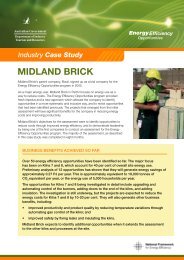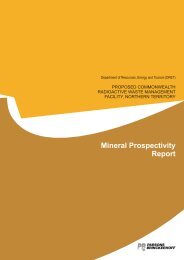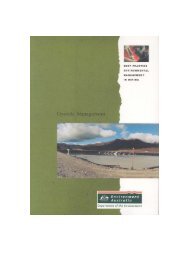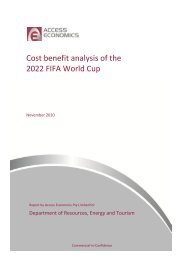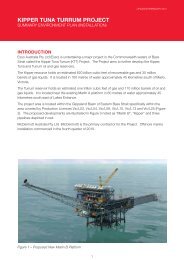A guide to leading practice sustainable development in mining
A guide to leading practice sustainable development in mining
A guide to leading practice sustainable development in mining
You also want an ePaper? Increase the reach of your titles
YUMPU automatically turns print PDFs into web optimized ePapers that Google loves.
Site water use<br />
Water is used for numerous tasks across the m<strong>in</strong>e site and will depend on the type of<br />
operation. Lead<strong>in</strong>g <strong>practice</strong> m<strong>in</strong>es m<strong>in</strong>imise water use while maximis<strong>in</strong>g water reuse.<br />
Water reuse is def<strong>in</strong>ed <strong>in</strong> a number of ways and is also often used <strong>in</strong>terchangeably<br />
with water recycl<strong>in</strong>g. Water reuse m<strong>in</strong>imises demand for water from off site and<br />
thereby focuses attention on <strong>lead<strong>in</strong>g</strong> management <strong>practice</strong>s with<strong>in</strong> the site. Lead<strong>in</strong>g<br />
operations generally have better control over water releases because reuse is carried<br />
out extensively and consistently.<br />
Olympic Dam recognises that the responsible use of Great Artesian Bas<strong>in</strong> (GAB)<br />
water is essential <strong>to</strong> protect the environmental values of the GAB spr<strong>in</strong>gs, a key<br />
concern for some of its stakeholders. The m<strong>in</strong>e moni<strong>to</strong>rs the rate at which it extracts<br />
water from the two wellfields <strong>to</strong> ensure that it is always with<strong>in</strong> prescribed limits and<br />
that adverse impacts are not occurr<strong>in</strong>g. The ongo<strong>in</strong>g challenge is <strong>to</strong> cont<strong>in</strong>ue <strong>to</strong> meet<br />
these limits while provid<strong>in</strong>g the opportunity <strong>to</strong> optimise plant production rates. The<br />
project confirmed the importance of regular <strong>in</strong>spection, test<strong>in</strong>g and calibration of<br />
process <strong>in</strong>dica<strong>to</strong>rs. Significant water sav<strong>in</strong>gs have been identified and implemented<br />
<strong>in</strong> the three key production areas (see LP Water p.57).<br />
Figure 4.23 – Ma<strong>in</strong> shaft at Olympic Dam<br />
Re-<strong>in</strong>jection <strong>in</strong><strong>to</strong> watercourses<br />
Re-<strong>in</strong>jection is the <strong>practice</strong> of replac<strong>in</strong>g groundwater <strong>in</strong><strong>to</strong> the same or a nearby<br />
aquifer. It can be achieved us<strong>in</strong>g eng<strong>in</strong>eer<strong>in</strong>g <strong>in</strong>frastructure and/or passive re<strong>in</strong>filtration<br />
via local water courses. In some circumstances it is preferable <strong>to</strong> releas<strong>in</strong>g<br />
water <strong>in</strong><strong>to</strong> surface water systems and/or rely<strong>in</strong>g on evaporation. Re-<strong>in</strong>jection is<br />
considered water diversion when the receiv<strong>in</strong>g aquifer is with<strong>in</strong> the lease boundary<br />
and as an output when it is outside the lease boundary.<br />
A GUIDE TO LEADING PRACTICE SUSTAINABLE DEVELOPMENT IN MINING 127






